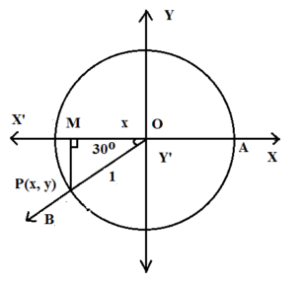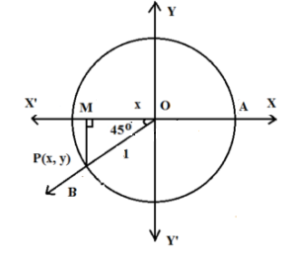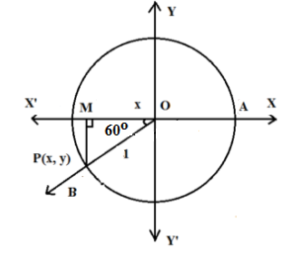In this article, we shall find values of trigonometric ratios of standard angles in the third and the fourth quadrants using a standard unit circle.
Trigonometric Ratios of 210o or (7π/6)c:
Let us consider a standard unit circle

Let m∠ AOP = θ = 210o = (7π/6)c
m∠ POM = 30o
Ray OA is the initial arm of the angle.
The terminal arm of the angle ray OP intersects the circle at P(x, y)
Let PM be perpendicular to OX’. Thus ΔOMP is 30o-60o-90o triangle
PM = 1/2(OP) = 1/2 (1) = 1/2 (side opposite to 30o)
OM = √3/2(OP) = √3/2 (1) = √3/2 (side opposite to 60o)
Point P is in the third quadrant
Hence x = -√3/2 an y = -1/2. Thus
sin 210o = y = – 1/2
cos 210o = x = – √3/2
tan 210o = y/x = (-1/2)/(-√3/2) = 1/√3
cosec 210o = 1/y = 1/(-1/2) = – 2
sec 210o = 1/x = 1/(-√3/2) = – 2/√3
cot 210o = x/y = (-√3/2)/(-1/2) = √3
| sin 210o sin (7π/6)c | cos 210o cos (7π/6)c | tan 210o tan (7π/6)c | cosec 210o cosec (π/6)c | sec 210o sec (7π/6)c | cot 210o cot (7π/6)c |
| – 1/2 | – √3/2 | 1/√3 | – 2 | – 2/√3 | √3 |
Trigonometric Ratios of 225o or (5π/4)c:
Let us consider a standard unit circle

Let m∠ AOP = θ = 225o = (5π/4)c
m∠ POM = 45o
Ray OA is the initial arm of the angle.
The terminal arm of the angle ray OP intersects the circle at P(x, y)
Let PM be perpendicular to OX’. Thus ΔOMP is 45o-45o-90o triangle
PM = 1/√2(OP) = 1/√2 (1) = 1/√2 (side opposite to 45o)
OM = 1/√2(OP) = 1/√2 (1) = √1/√2 (side opposite to 45o)
Point P is in the third quadrant
Hence x = – 1/√2 an y = – 1/√2. Thus
sin 225o = y = – 1/√2
cos 225o = x = – 1/√2
tan 22o = y/x = (-1/√2)/(- 1/√2) = 1
cosec 225o = 1/y = 1/(-1/√2) = – √2
sec 225o = 1/x = 1/(-1/√2) = – √2
cot 225o = x/y = (-1/√2)/(-1/√2) = 1
| sin 225o sin (5π/4)c | cos 225o cos (5π/4)c | tan 225o tan (5π/4)c | cosec 225o cosec (5π/4)c | sec 225o sec (5π/4)c | cot 225o cot (5π/4)c |
| – 1/√2 | – 1/√2 | 1 | – √2 | – √2 | 1 |
Trigonometric Ratios of 240o or (4π/3)c:
Let us consider a standard unit circle

Let m∠ AOP = θ = 240o = (4π/3)c
m∠ POM = 60o
Let PM be perpendicular to OX’. Thus ΔOMP is 30o-60o-90o triangle
PM = √3/2(OP) = 1/2 (1) = √3/2 (side opposite to 60o)
OM = 1/2(OP) = √3/2 (1) = 1/2 (side opposite to 30o)
Point P is in the third quadrant
Hence x = – 1/2 an y = – √3/2. Thus
sin 240o = y = – √3/2
cos 240o = x = -1/2
tan 240o = y/x = (-√3/2)/(-1/2) = √3
cosec 240o = 1/y = 1/(-√3/2) = – 2/√3
sec 240o = 1/x = 1/(-1/2) = – 2
cot 240o = x/y = (-1/2)/(-√3/2) = 1/√3
| sin 240o sin (4π/3)c | cos 240o cos (4π/3)c | tan 240o tan (4π/3)c | cosec 240o cosec (4π/3)c | sec 240o sec (4π/3)c | cot 240o cot (4π/3)c |
| – √3/2 | -1/2 | √3 | – 2/√3 | – 2 | 1/√3 |
Trigonometric Ratios of 270o or (3π/2)c:
Let us consider a standard unit circle

Let m∠ AOP = θ = 270o = (3π/2)c
Let PM be perpendicular to OX. M coicides with O
PM = 1 and OM = 0
Point P is on negative y-axis
Hence x = 0 an y = -1. Thus
sin 270o = y = -1
cos 270o = x = 0
tan 270o = y/x (Not defined since x = 0)
cosec 270o = 1/y = 1/-1 = -1
sec 270o = 1/x (Not defined since x = 0)
cot 270o = x/y = 0/-1 = 0
| sin 270o sin (π/2)c | cos 270o cos (π/2)c | tan 270o tan (π/2)c | cosec 270o cosec (π/2)c | sec 270o sec (π/2)c | cot 270o cot (π/2)c |
| – 1 | 0 | – | – 1 | – | 0 |
Trigonometric Ratios of 300o or (5π/3)c:
Let us consider a standard unit circle

Let m∠ AOP = θ = 300o = (5π/3)c
Let PM be perpendicular to OX. Thus ΔOMP is 30o-60o-90o triangle
PM = √3/2(OP) = 1/2 (1) = √3/2 (side opposite to 60o)
OM = 1/2(OP) = √3/2 (1) = 1/2 (side opposite to 30o)
Point P is in the fourth quadrant
Hence x = 1/2 an y = – √3/2. Thus
sin 300o = y = – √3/2
cos 300o = x = 1/2
tan 300o = y/x = (-√3/2)/(1/2) = – √3
cosec 300o = 1/y = 1/(- √3/2) = – 2/√3
sec 300o = 1/x = 1/(1/2) = 2
cot 300o = x/y = (1/2)/(- √3/2) = – 1/√3
| sin 300o sin (5π/3)c | cos 300o cos (5π/3)c | tan 300o tan (5π/3)c | cosec 300o cosec (5π/3)c | sec 300o sec (5π/3)c | cot 30o cot (5π/3)c |
| – √3/2 | 1/2 | – √3 | – 2/√3 | 2 | – 1/√3 |
Trigonometric Ratios of 315o or (7π/4)c:
Let us consider a standard unit circle

Let m∠ AOP = θ = 315o = (7π/4)c
Ray OA is the initial arm of the angle.
The terminal arm of the angle ray OP intersects the circle at P(x, y)
Let PM be perpendicular to OX. Thus ΔOMP is 45o-45o-90o triangle
PM = 1/√2(OP) = 1/√2 (1) = 1/√2 (side opposite to 45o)
OM = 1/√2(OP) = 1/√2 (1) = 1/√2 (side opposite to 45o)
Point P is in the fourth quadrant
Hence x = 1/√2 an y = -1/√2. Thus
sin 315o = y = – 1/√2
cos 315o = x = √1/√2
tan 315o = y/x = (-1/√2)/(1/√2) = – 1
cosec 315o = 1/y = 1/(-1/√2) = – √2
sec 315o = 1/x = 1/(1/√2) = √2
cot 315o = x/y = (1/√2)/(-1/√2) = – 1
| sin 315o sin (7π/4)c | cos 315o cos (7π/4)c | tan 315o tan (7π/4)c | cosec 315o cosec (7π/4)c | sec 315o sec (7π/4)c | cot 315o cot (7π/4)c |
| – 1/√2 | 1/√2 | – 1 | – √2 | √2 | – 1 |
Trigonometric Ratios of 330o or (11π/6)c:
Let us consider a standard unit circle

Let m∠ AOP = θ = 330o = (11π/6)c
Ray OA is the initial arm of the angle.
The terminal arm of the angle ray OP intersects the circle at P(x, y)
Let PM be perpendicular to OX. Thus ΔOMP is 30o-60o-90o triangle
PM = 1/2(OP) = 1/2 (1) = 1/2 (side opposite to 30o)
OM = √3/2(OP) = √3/2 (1) = √3/2 (side opposite to 60o)
Point P is in the fourth quadrant
Hence x = √3/2 an y = – 1/2. Thus
sin 330o = y = – 1/2
cos 330o = x = √3/2
tan 330o = y/x = (-1/2)/(√3/2) = – 1/√3
cosec 330o = 1/y = 1/(-1/2) = – 2
sec 330o = 1/x = 1/(√3/2) = 2/√3
cot 330o = x/y = (√3/2)/(-1/2) = – √3
| sin 330o sin (11π/6)c | cos 330o cos (11π/6)c | tan 330o tan (11π/6)c | cosec 330o cosec (11π/6)c | sec 330o sec (11π/6)c | cot 330o cot (11π/6)c |
| – 1/2 | √3/2 | – 1/√3 | – 2 | 2/√3 | – √3 |
Trigonometric Ratios of 360o or 2πc:
Let us consider a standard unit circle

Let m∠ AOP = θ = 360o = 2πc
Ray OA is the initial arm of the angle.
The terminal arm of the angle ray OP intersects the circle at P(1, 0)
Hence x = 1 an y = 0. Thus
sin 360o = y = 0
cos 360o = x = 1
tan 360o = y/x = 0/1 = 0
cosec 360o = 1/y (Not defined since y = 0)
sec 360o = 1/x = 1/1 = 1
cot 360o = x/y (Not defined since y = 0)
| sin 360o sin (π)c | cos 360o cos (π)c | tan 360o tan (π)c | cosec 360o cosec (π)c | sec 360o sec (π)c | cot 360o cot (π)c |
| 0 | 1 | 0 | – | 1 | – |